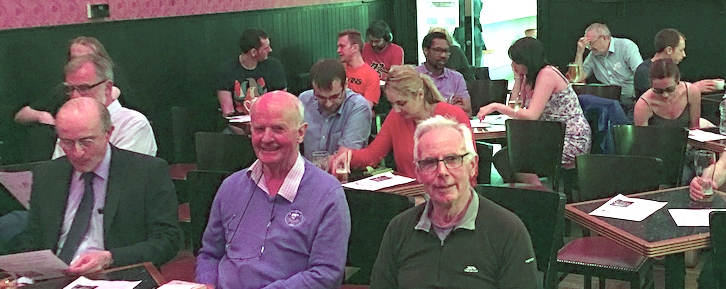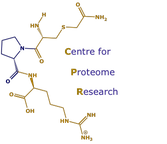It’s all about the actors, darling!
It’s all about the actors, darling!
I had the pleasure of delivering a Café Scientifique discussion in Glasgow in May. This is a very long running forum, and has been run by Professor Mandy McLean and her colleagues since 2004 (Prof McLean received an MBE in 2010 for her public engagement activities – who says outreach doesn’t get recognised?).
The title of my talk was ‘The cell, a factory run by actors’. The format was a 20minute introduction (no slides, no projector –a refreshing change that would do us all good from time to time – I prepared so much better without the crutch of slides to prop me up) - I introduced myself as a protein chemist, discussed proteins I had discovered in my career, and the fun to be had in naming them (the darcin story always gets a good reception) and then explained how ‘proteins’ (the term coined by Berzelius in 1838 from the Greek πρώτειος (‘proteios’), meaning ‘of the first rank’) had been embedded in literature and arts (think Kurt Vonnegut in ‘Cat’s Cradle’ and ‘Space Oddity’, just for starters) but I also quoted one of my favourite books, 'For the Love of Enzymes: The Odyssey of a Biochemist’ in which he said, paraphrasing “DNA and RNA provide the script, but proteins are the actors”.

I then directed the audience (between 30 and 40 people) to the first question on my short pub quiz. They were challenged to calculate how many possible proteins of 300 amino acids there could be (prefaced by a chat about polymers, building blocks and the significance of precise order). The audience did it! As Douglas Adams might have said, the answer is ‘a hugely, mindbogglingly big number’ and far exceeds the number of atoms in the Universe. We then addressed the logical outcome, that the evolution of life on this planet very quickly got locked into a tiny little corner of the hyperdimensional space of ‘all possible proteins’, and that ‘out there’ in that hyperdimensional space, there were perfect antimicrobials, cures for all diseases, proteins that could support green chemistry, proteins that were as clear and sparkled like diamonds. If only we knew how to get to them (and synthetic biology is not the answer).
The second part of my short introduction talked about complexity. We discussed the size of a yeast cell (100 cells end to end in one millimetre) and the complexity of this cell compared to an Airbus A3800 – the yeast cell has about 60 million molecules, the A380 has only 4 million parts, which led to the final part of my introduction – how do you manage this complexity, controlling the number of each protein a cell needs, and changing those numbers to respond to demand (stimuli) Is the cell a ‘just in time’ manufacturer, a ‘just in case’ manufacturer or a ‘rapid recycler’?
The following discussion (90minutes, with a very welcome bar break in the middle) was fabulous. This was a switched on audience – we ranged from pre-biotic evolution through panspermy to insulin secretion as a ‘just in time’ process. Inevitably, the darcin story took us back to a detailed discussion about the sex life of the mouse, a chance to amuse, inform and extol the value of multidisciplinary collaboration with Jane Hurst and colleagues in Leahurst as behavioural ecologists par excellence.
Inevitably we addressed the issue of how we do this work and the need for protein chemists to be ‘technologically overstimulated’ -especially for the big projects like our recently published study that quantified the number, in copies per cell, of over 2,000 yeast proteins.
I loved every minute of it. The QandA session was chaired by Vanessa Collingridge, broadcaster and writer, who was terrific.
To any of my colleagues who are thinking about this, my advice is ‘go for it!’. Leave the slides behind, don’t overplay the minutiae, and enjoy two hours in the company of an interested and intelligent audience who challenge you to jump around in your favourite playground – the subject that brings you in to work every morning with a bounce!
I had the pleasure of delivering a Café Scientifique discussion in Glasgow in May. This is a very long running forum, and has been run by Professor Mandy McLean and her colleagues since 2004 (Prof McLean received an MBE in 2010 for her public engagement activities – who says outreach doesn’t get recognised?).
The title of my talk was ‘The cell, a factory run by actors’. The format was a 20minute introduction (no slides, no projector –a refreshing change that would do us all good from time to time – I prepared so much better without the crutch of slides to prop me up) - I introduced myself as a protein chemist, discussed proteins I had discovered in my career, and the fun to be had in naming them (the darcin story always gets a good reception) and then explained how ‘proteins’ (the term coined by Berzelius in 1838 from the Greek πρώτειος (‘proteios’), meaning ‘of the first rank’) had been embedded in literature and arts (think Kurt Vonnegut in ‘Cat’s Cradle’ and ‘Space Oddity’, just for starters) but I also quoted one of my favourite books, 'For the Love of Enzymes: The Odyssey of a Biochemist’ in which he said, paraphrasing “DNA and RNA provide the script, but proteins are the actors”.

I then directed the audience (between 30 and 40 people) to the first question on my short pub quiz. They were challenged to calculate how many possible proteins of 300 amino acids there could be (prefaced by a chat about polymers, building blocks and the significance of precise order). The audience did it! As Douglas Adams might have said, the answer is ‘a hugely, mindbogglingly big number’ and far exceeds the number of atoms in the Universe. We then addressed the logical outcome, that the evolution of life on this planet very quickly got locked into a tiny little corner of the hyperdimensional space of ‘all possible proteins’, and that ‘out there’ in that hyperdimensional space, there were perfect antimicrobials, cures for all diseases, proteins that could support green chemistry, proteins that were as clear and sparkled like diamonds. If only we knew how to get to them (and synthetic biology is not the answer).
The second part of my short introduction talked about complexity. We discussed the size of a yeast cell (100 cells end to end in one millimetre) and the complexity of this cell compared to an Airbus A3800 – the yeast cell has about 60 million molecules, the A380 has only 4 million parts, which led to the final part of my introduction – how do you manage this complexity, controlling the number of each protein a cell needs, and changing those numbers to respond to demand (stimuli) Is the cell a ‘just in time’ manufacturer, a ‘just in case’ manufacturer or a ‘rapid recycler’?
The following discussion (90minutes, with a very welcome bar break in the middle) was fabulous. This was a switched on audience – we ranged from pre-biotic evolution through panspermy to insulin secretion as a ‘just in time’ process. Inevitably, the darcin story took us back to a detailed discussion about the sex life of the mouse, a chance to amuse, inform and extol the value of multidisciplinary collaboration with Jane Hurst and colleagues in Leahurst as behavioural ecologists par excellence.
Inevitably we addressed the issue of how we do this work and the need for protein chemists to be ‘technologically overstimulated’ -especially for the big projects like our recently published study that quantified the number, in copies per cell, of over 2,000 yeast proteins.
I loved every minute of it. The QandA session was chaired by Vanessa Collingridge, broadcaster and writer, who was terrific.
To any of my colleagues who are thinking about this, my advice is ‘go for it!’. Leave the slides behind, don’t overplay the minutiae, and enjoy two hours in the company of an interested and intelligent audience who challenge you to jump around in your favourite playground – the subject that brings you in to work every morning with a bounce!
